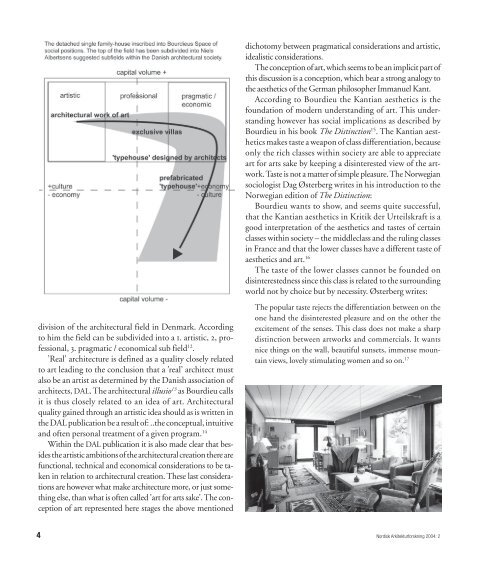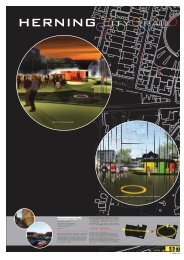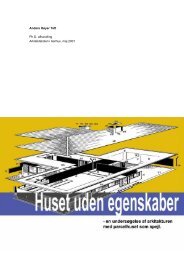art Anders Toft - Toft Arkitektur
art Anders Toft - Toft Arkitektur
art Anders Toft - Toft Arkitektur
Create successful ePaper yourself
Turn your PDF publications into a flip-book with our unique Google optimized e-Paper software.
dichotomy between pragmatical considerations and <strong>art</strong>istic,<br />
idealistic considerations.<br />
The conception of <strong>art</strong>, which seems to be an implicit p<strong>art</strong> of<br />
this discussion is a conception, which bear a strong analogy to<br />
the aesthetics of the German philosopher Immanuel Kant.<br />
According to Bourdieu the Kantian aesthetics is the<br />
foundation of modern understanding of <strong>art</strong>. This understanding<br />
however has social implications as described by<br />
Bourdieu in his book The Distinction 15 . The Kantian aesthetics<br />
makes taste a weapon of class differentiation, because<br />
only the rich classes within society are able to appreciate<br />
<strong>art</strong> for <strong>art</strong>s sake by keeping a disinterested view of the <strong>art</strong>work.<br />
Taste is not a matter of simple pleasure. The Norwegian<br />
sociologist Dag Østerberg writes in his introduction to the<br />
Norwegian edition of The Distinction:<br />
Bourdieu wants to show, and seems quite successful,<br />
that the Kantian aesthetics in Kritik der Urteilskraft is a<br />
good interpretation of the aesthetics and tastes of certain<br />
classes within society – the middleclass and the ruling classes<br />
in France and that the lower classes have a different taste of<br />
aesthetics and <strong>art</strong>. 16<br />
The taste of the lower classes cannot be founded on<br />
disinterestedness since this class is related to the surrounding<br />
world not by choice but by necessity. Østerberg writes:<br />
division of the architectural field in Denmark. According<br />
to him the field can be subdivided into a 1. <strong>art</strong>istic, 2, professional,<br />
3. pragmatic / economical sub field 12 .<br />
’Real’ architecture is defined as a quality closely related<br />
to <strong>art</strong> leading to the conclusion that a ’real’ architect must<br />
also be an <strong>art</strong>ist as determined by the Danish association of<br />
architects, DAL. The architectural illusio 13 as Bourdieu calls<br />
it is thus closely related to an idea of <strong>art</strong>. Architectural<br />
quality gained through an <strong>art</strong>istic idea should as is written in<br />
the DAL publication be a result of: ..the conceptual, intuitive<br />
and often personal treatment of a given program. 14<br />
Within the DAL publication it is also made clear that besides<br />
the <strong>art</strong>istic ambitions of the architectural creation there are<br />
functional, technical and economical considerations to be taken<br />
in relation to architectural creation. These last considerations<br />
are however what make architecture more, or just something<br />
else, than what is often called ’<strong>art</strong> for <strong>art</strong>s sake’. The conception<br />
of <strong>art</strong> represented here stages the above mentioned<br />
The popular taste rejects the differentiation between on the<br />
one hand the disinterested pleasure and on the other the<br />
excitement of the senses. This class does not make a sharp<br />
distinction between <strong>art</strong>works and commercials. It wants<br />
nice things on the wall, beautiful sunsets, immense mountain<br />
views, lovely stimulating women and so on. 17<br />
4 Nordisk <strong>Arkitektur</strong>forskning 2004: 2







